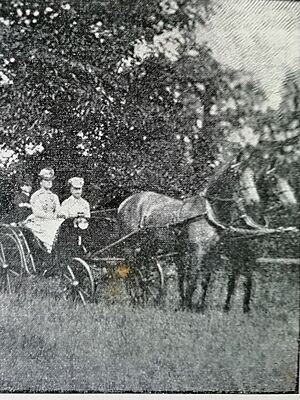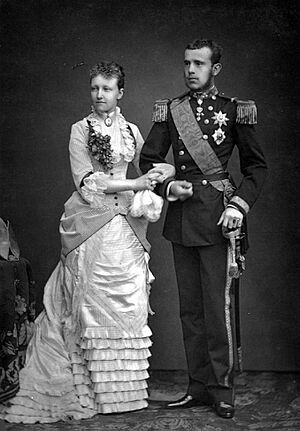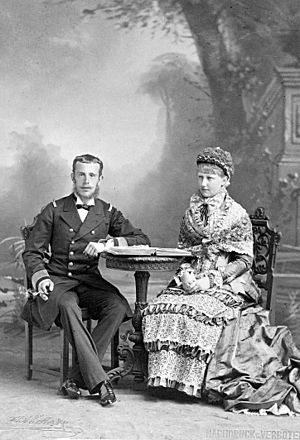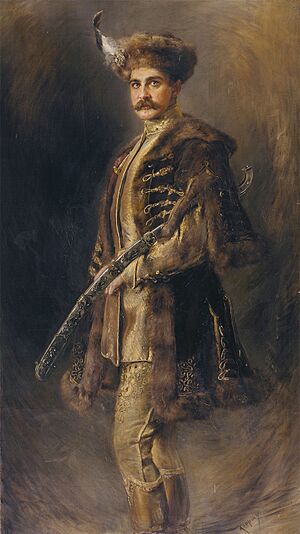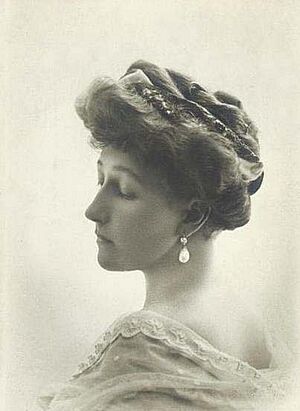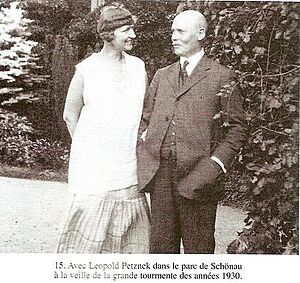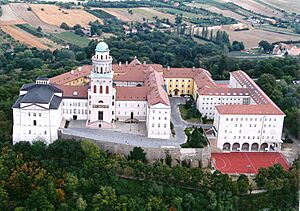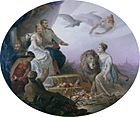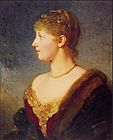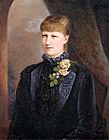Princess Stéphanie of Belgium facts for kids
Quick facts for kids Stéphanie of Belgium |
|||||
|---|---|---|---|---|---|
| Crown Princess of Austria, Hungary and Bohemia Princess Elemér Lónyay de Nagy-Lónya |
|||||
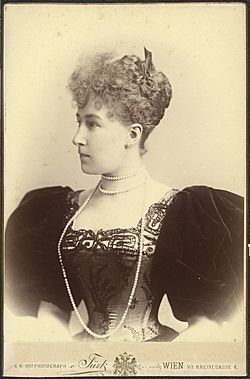
Crown Princess Stéphanie, c. 1885
|
|||||
| Born | 21 May 1864 Palace of Laeken, Laeken, Brussels, Belgium |
||||
| Died | 23 August 1945 (aged 81) Pannonhalma Archabbey, Pannonhalma, Hungary |
||||
| Burial | Pannonhalma Archabbey | ||||
| Spouse |
Prince Elemér Lónyay of Nagy-Lónya
(m. 1900) |
||||
| Issue | Elisabeth Marie, Princess Otto of Windisch-Graetz | ||||
|
|||||
| House | Saxe-Coburg and Gotha | ||||
| Father | Leopold II of Belgium | ||||
| Mother | Marie Henriette of Austria | ||||
| Religion | Roman Catholicism | ||||
Princess Stéphanie Clotilde Louise Herminie Marie Charlotte of Belgium (born 21 May 1864 – died 23 August 1945) was a Belgian princess. She became the Crown Princess of Austria when she married Crown Prince Rudolf. Rudolf was the heir to the throne of the Austro-Hungarian Empire.
Princess Stéphanie was the second daughter of King Leopold II of Belgium and Marie Henriette of Austria. She married Crown Prince Rudolf in Vienna on 10 May 1881. Rudolf was the son of Emperor Franz Joseph I of Austria. They had one daughter, Archduchess Elisabeth Marie. Their marriage became difficult. In 1889, Rudolf and a friend were found dead at a hunting lodge.
In 1900, Stéphanie married again to Prince Elemér Lónyay, a Hungarian nobleman. This marriage was a happy one. After her father died in 1909, Stéphanie and her older sister Louise tried to claim their share of his inheritance.
Before World War II, Stéphanie and Prince Lónyay lived peacefully at Rusovce Mansion in Slovakia. In 1935, Stéphanie published her memories called Je devais être impératrice ("I Had to Be Empress"). In 1944, she decided her daughter would not inherit from her. This was because her daughter had divorced and lived with a socialist politician. In April 1945, the Red Army arrived, forcing Stéphanie and her husband to leave their home. They found safety in the Pannonhalma Archabbey in Hungary. Stéphanie died there later that year from a stroke.
Contents
Life of Princess Stéphanie
Early Years and Family Life
Family Background and Birth
Stéphanie was the third child of the Duke (who would become King Leopold II) and Duchess of Brabant. Her parents had an unhappy marriage. Their marriage in 1853 was arranged for political reasons. The Duke of Brabant was interested in politics. Marie Henriette loved horseback riding, dogs, and music.
Stéphanie was born at the Palace of Laeken on 21 May 1864. She was given an emergency baptism that day. Her official baptism happened a month later, on 25 June. She was named Stéphanie Clotilde Louise Herminie Marie Charlotte. Her first two names honored her godparents.
Stéphanie had two older siblings: Louise (born 1858) and Leopold (born 1859). In 1865, her grandfather, King Leopold I, died. Her father became King Leopold II. Her brother Leopold became the new heir to the throne.
A Difficult Childhood
In 1868, Stéphanie's brother Leopold, the heir to the throne, became very ill. He was almost 9 years old. His health got worse quickly. He died on 22 January 1869.
Stéphanie wrote in her memories about her brother's death. She said it was the first event deeply etched in her memory. She remembered her mother's great sadness. Her mother had changed a lot after losing her son.
In 1871, typhus and smallpox spread in Brussels. Stéphanie, not yet seven, caught typhus. Her parents were very worried. They feared losing another child. For many weeks, she was unconscious and in pain. A doctor saved her with cold baths. By October, Stéphanie had recovered.
Her parents hoped for another son. But in 1872, another daughter, Clémentine, was born. She was their last child. After this, King Leopold II became less interested in his family. He focused on creating the Congo Free State.
Learning and Strict Rules
From 1874, Stéphanie's education began. She was taught by teachers who gave her many lessons. These included French, English, German, Dutch, and Hungarian. She also learned mathematics, history, art history, and religion. However, her education was not very advanced.
Life was very strict for the princesses. They woke up early, at five or six in the morning. Silence was required during their morning routine. They had to dress and comb their own hair. Their rooms were kept cold, even in winter. They had to dust their own rooms.
Sometimes, they ate breakfast with the King and Queen. They were not allowed to eat the sweets on the table. If Stéphanie was punished, she had to kneel on dry peas. Or she was locked in a dark room for hours. Only their maid, Toni, showed them constant affection. Holidays like Easter and Christmas were the only times they were spoiled.
Crown Princess of Austria-Hungary
Marriage Plans
Stéphanie's older sister, Louise, married in 1875. She married Prince Philipp of Saxe-Coburg and Gotha, a wealthy cousin. Stéphanie continued her studies and cared for her younger sister, Clémentine.
Stéphanie made her first communion in 1876. She then appeared at court for the first time. Rumors about her possible marriage began to spread. Her parents hoped she would marry a king or a crown prince.
In 1878, Empress Elisabeth of Austria (also known as "Sissi") visited Brussels. Stéphanie, then 14, met her. The Empress was the mother of Crown Prince Rudolf. The court in Vienna wanted Rudolf to marry young and have children. In March 1880, Rudolf visited the Belgian court. He met 15-year-old Princess Stéphanie. He wrote to his mother that he found her "pretty, good, [and] clever."
Stéphanie was not Rudolf's first choice for a wife. He had refused other princesses. But Stéphanie was one of the few Catholic princesses who met his father's requirements. His parents pressured him to marry soon. On 5 March, Rudolf asked Stéphanie's parents for her hand in marriage. Emperor Franz Joseph I was pleased with the match. Stéphanie remembered her father telling her she was chosen to be Empress of Austria.
Engagement and Wedding
Their engagement was made official on 7 March 1880. Stéphanie was not yet 16 years old. Rudolf was 21. He already had his own home and commanded an infantry regiment. His aunt, Countess Marie Larisch von Moennich, felt sorry for the princess chosen to be his wife.
King Leopold II was very proud of the wedding preparations. The Austrian Emperor added money to Stéphanie's dowry. Stéphanie went to Vienna to learn about Imperial court manners. The wedding was planned for 15 February 1881. But it was delayed because Stéphanie was not yet old enough. She returned home for a while.
The wedding finally took place on 10 May 1881. This was just a few days before Stéphanie's 17th birthday. It was held at the Saint Augustine's Church in Vienna. Many important guests attended, including the future King Edward VII of the United Kingdom. Stéphanie described the joyful atmosphere. She became the Crown Princess of Austria-Hungary.
Life at the Vienna Court
After their wedding, the couple went on their honeymoon to Laxenburg. Stéphanie faced many questions from her new family. She had to spend most of her time with them. Her mother-in-law, Empress Elisabeth, was not kind to her. But Stéphanie began to enjoy her new position. She was cheered during a visit to Hungary.
At first, Stéphanie and Rudolf had a respectful relationship. They had nicknames for each other: "Coco" for Rudolf and "Coceuse" for Stéphanie. Stéphanie described Rudolf as a "model husband." She said they understood each other well. However, Stéphanie was not allowed to leave the palace often. She spent her time drawing or painting.
From October 1881, Stéphanie took over official duties from the Empress. She accompanied the Emperor and Crown Prince on official trips. She also hosted dinners. Empress Elisabeth preferred to travel. Rudolf became less warm towards his wife.
In 1883, Stéphanie's pregnancy was confirmed. This made the Emperor very happy. Rudolf became attentive to his wife again. Both Stéphanie and Rudolf were sure it would be a boy. On 2 September, Stéphanie gave birth to a daughter, Elisabeth Marie. She was known as "Erzsi." Rudolf was disappointed it was not a boy. But he grew to love his role as a father. This birth, however, marked the start of serious marital problems.
Rudolf's Illness and Its Impact
The couple hosted many visitors and dinners in Prague and Vienna. Stéphanie took her role seriously. Rudolf disagreed with his father's policies. He became friends with people who opposed the monarchy. In 1886, Rudolf became very ill. Doctors gave different reasons for his sickness.
Rudolf went to the island of Lokrum to recover. Stéphanie went with him. She was not told the true nature of his illness. When she started feeling unwell herself, doctors said it was peritonitis. This was a lie. Stéphanie later found out she could not have more children. She felt betrayed by Rudolf. She became resentful and bitter towards him. She refused to live as his wife. Rudolf tried to make up, but their problems were deep.
In 1887, Stéphanie fell in love with a Polish nobleman, Artur Władysław Potocki. She did not hide her feelings from Rudolf. From 1887, the couple had many arguments. Rudolf began to lose control. He suffered from deep sadness and anger. He often spoke about his coming death. In 1888, Stéphanie noticed a worrying change in Rudolf. He became very violent in public.
Life as a Widow
After Rudolf's death, Stéphanie wanted to leave Vienna. She wanted to go to her parents in Brussels. But neither King Leopold II nor Emperor Franz Joseph I allowed her to leave Austria. The Emperor wanted her to stay with her 5-year-old daughter, Elisabeth Marie. Stéphanie had to obey. She was allowed to stay at Miramare Castle for four months. She lived a quiet life at first. Over time, she saw her daughter less often.
Stéphanie continued her relationship with Count Potocki. He was a Chamberlain at the Vienna court. Only her sister Louise knew about their affair. Artur Potocki supported Stéphanie after Rudolf's death. However, the Count became very ill. He died in March 1890. Stéphanie was deeply sad once again.
At the Vienna court, Stéphanie felt coldness from Empress Elisabeth and Emperor Franz Joseph I. She kept her title of Crown Princess but lost her official duties. She was no longer allowed to represent the Empress. She traveled a lot and painted watercolors. She also enjoyed singing, theater, and concerts.
Until 1898, Stéphanie traveled extensively each year. She visited places like Corfu, Malta, Tunis, and Sicily. She also went to the Nordic countries, North Africa, and Russia. In March 1898, she became very ill with pneumonia. Her life was in danger, but she recovered. On 10 September 1898, Empress Elisabeth was killed in Geneva. Stéphanie was very affected by this unexpected death.
A New Chapter in Life
A Marriage for Love
Emperor Franz Joseph I and King Leopold II wanted Stéphanie to marry Archduke Franz Ferdinand of Austria. He was the new heir to the Austro-Hungarian Empire. But Franz Ferdinand wanted to marry someone else.
Stéphanie planned to marry Count Elemér Lónyay. He was a Hungarian nobleman and a Protestant. He was one year older than her. He had worked in diplomacy in many countries. In 1896, he became a Count. To marry Stéphanie, he converted to Catholicism.
Stéphanie was afraid to tell her father about her marriage plans. She wrote to Queen Victoria in October 1899, who supported her. But the King of Belgium refused to let his daughter marry a man of lower rank. He was very angry. He even tried to take away her royal title. The Belgian rulers cut off contact with Stéphanie. They forbade her to return to Belgium.
On 22 March 1900, Stéphanie married Count Elemér Lónyay at Miramare Castle. She had been a widow for eleven years. The Emperor reluctantly gave his permission. But Stéphanie lost her royal titles by remarrying. Her daughter Elisabeth Marie stayed in Vienna with her grandfather. Stéphanie's staff was dismissed. She received a yearly pension. Her new husband also had an income.
The Austrian newspapers saw this marriage as romantic. The new couple first lived in Vienna.
Family Matters
Two years after her mother remarried, Archduchess Elisabeth Marie married Prince Otto Weriand of Windisch-Graetz. This was on 23 January 1902. Her grandfather, Emperor Franz Joseph I, did not approve. A few months later, Stéphanie learned her mother, Queen Marie Henriette, had died. She went to Spa to pay her respects. But King Leopold II was still angry about Stéphanie's marriage. He forbade her from attending the funeral. She had to return to London.
When King Leopold II died on 17 December 1909, Stéphanie was refused a last meeting with him. Her sister Louise also returned to Belgium and was refused. Stéphanie and her sisters found out their father had left most of his money to his mistress. He also hid property to prevent his daughters from getting it. The Belgian state offered the three princesses money. Stéphanie and Clémentine accepted. But Louise refused and started lawsuits. In 1914, an agreement was reached. Louise, like her sisters, received money from their father's fortune.
Peaceful Life in Hungary
In January 1906, Stéphanie and Elemér bought the Rusovce Mansion in Hungary (now in Slovakia). They made it their permanent home. The mansion had 200 rooms and a large park. They hosted many guests there. These included Archduke Franz Ferdinand and writers. Elemér displayed his art collections. Stéphanie and her husband created three beautiful gardens.
World War I
When Stéphanie heard about the killing of Archduke Franz Ferdinand in Sarajevo in 1914, she believed Emperor Franz Joseph I had wanted it. Four weeks later, war began. Stéphanie set up a hospital in her Rusovce home. She worked as a nurse. Elemér worked for the Austrian Red Cross.
In November 1916, Emperor Franz Joseph I's health declined. He died on 21 November 1916 at age 86. Stéphanie and her daughter Elisabeth Marie attended the funeral. The new Emperor Charles I led the procession. The Emperor granted Elemér the title of Hungarian Prince in 1917. After the war ended in 1918, the Austro-Hungarian Empire no longer existed. The imperial family had to leave Austria. But Stéphanie and her daughter were excluded from this rule.
Between the Wars
Until World War II, Prince and Princess Lónyay lived peacefully at Rusovce. Stéphanie and her daughter Elisabeth Marie had a strong bond. They wrote many letters to each other. In 1922, Stéphanie was happy to host her two oldest grandsons. But the teenagers found their grandmother's ways very different. Stéphanie's last letter to her daughter was in 1924. The following year, Elisabeth Marie attended her mother's 25th wedding anniversary. After that, they did not see each other again. Stéphanie believed her daughter was immoral.
In 1923, Stéphanie planned to write her memories. She worked with a biographer. But she stopped the collaboration in 1933. She decided to write the book herself. Her book, Ich sollte Kaiserin werden (I Was To Be Empress), was published in 1935. It was censored in Austria at first. It was later published in French as Je devais être impératrice (I Had To Be Empress).
Final Years and Death
As long as they were healthy, Stéphanie and Elemér traveled. They met exiled rulers. Gradually, they stayed more at their estate. They lived a quiet life, focused on religion.
In July 1944, Stéphanie wrote her will. She decided her daughter would not inherit anything. She left all her property to the Benedictine order. In return, the Benedictines would manage their debts and estates. In 1944, the German Army wanted to use their home as a hospital. This plan was rejected. Later, a German SS officer took over most of their castle. Stéphanie and Elemér had to live in a few rooms.
On 2 April 1945, the Red Army reached the Rusovce mansion. The Lónyays stayed at home for a few weeks. In May, Stéphanie, who had heart disease, and her husband left. They found safety in the Pannonhalma Archabbey. Three months later, on 23 August 1945, Stéphanie died there from a stroke. She was 81. Her daughter and descendants were not at her funeral. She was buried in the crypt of Pannonhalma Archabbey. Elemér died less than a year later and was buried next to her.
Aftermath
Stéphanie's only daughter, Archduchess Elisabeth Marie, divorced her husband in 1948. On 4 May of that year, she married her long-time partner, Leopold Petznek. She was distant from her four children. After Leopold Petznek died in 1956, Elisabeth Marie became very private. She died on 16 March 1963 in Vienna. She was buried in an unmarked tomb next to her husband. Like her mother, she also disinherited her two surviving children. She left many family heirlooms to the Republic of Austria. She left her large park to the city of Vienna for new housing.
Elisabeth Marie had four children from her first marriage:
- Prince Franz Joseph of Windisch-Graetz (born 1904 – died 1981). He had two children.
- Prince Ernst of Windisch-Graetz (born 1905 – died 1952). He had children from two marriages.
- Prince Rudolph of Windisch-Graetz (born 1907 – died 1930).
- Princess Stephanie of Windisch-Graetz (born 1909 – died 2005). She had children from two marriages.
As of 2021, Stéphanie had many great-grandchildren, great-great-grandchildren, and great-great-great-grandchildren.
Invention
The New York Times reported that Stéphanie "invented a new chafing dish and spirit lamp combined." She got patents for it in several countries, including England, France, and the United States. Her decision to get a US patent in 1908 was surprising.
Titles and Honors
Titles Held by Stéphanie
When she was born, Stéphanie was called Her Royal Highness Princess Stéphanie of Saxe-Coburg and Gotha. She was also Duchess in Saxony. Later, she was officially recognized as Princess of Belgium.
- 21 May 1864 – 10 May 1881: Her Royal Highness Princess Stéphanie of Saxe-Coburg and Gotha, Duchess in Saxony
- 10 May 1881 – 30 January 1889: Her Imperial and Royal Highness the Crown Princess of Austria, Hungary, Bohemia and Croatia
- 30 January 1889 – 22 March 1900: Her Imperial and Royal Highness the Dowager Crown Princess of Austria, Hungary, Bohemia and Croatia
- 22 March 1900 – 28 January 1917: Her Royal Highness Princess Stéphanie, Countess Elemér Lónyay de Nagy-Lónya
- 28 January 1917 – 23 August 1945: Her Royal Highness Princess Elemér Lónyay de Nagy-Lónya.
Heraldry
 Coat of Arms of Stéphanie as Princess of Belgium |
 Imperial Monogram of Stéphanie as Crown Princess of Austria |
Legacy and Recognition
Places Named After Her
- In Brussels, a street called "Avenue Stéphanie" was named after her in 1875.
- Also in Brussels, the "Stéphanie Tunnel" is a road tunnel completed in 1957.
- The steamboat Archiduchesse Stéphanie was built in 1890. It was used in the Haut-Congo region.
- Lake Chew Bahir in Ethiopia was discovered in 1887-1888. It was named Lake Stéphanie to honor the princess.
- In Croatia, in the Plitvice Lakes National Park, there is an island called "Stephanie's islet" in Lake Kozjak.
Space and Nature
- 220 Stephania is an asteroid discovered in 1881. It was named after her.
- The Stephanie's astrapia is a type of bird-of-paradise. It was named in her honor in 1884.
Art and Media
Stéphanie has been shown in several paintings:
-
Princess Stéphanie of Beligum, by Hans Makart (1880). Kunsthistorisches Museum, Vienna.
She has also been portrayed in films and TV shows:
- Mayerling, a French film from 1936.
- The Secret of Mayerling, a French film from 1949.
- Mayerling, a Franco-British film from 1968.
- The British TV series Fall of Eagles (1974).
- Kenneth MacMillan's 1978 ballet, Mayerling.
- ', an Austro-Franco-German-Italian TV movie from 2006.
- Frank Wildhorn's 2008 Musical, Rudolf The Mayerling Affair.
Awards and Decorations
 Austria-Hungary
Austria-Hungary
 Persia
Persia
 Portugal
Portugal
 Spain
Spain
 Dame of the Order of Queen Maria Luisa, 16 May 1881
Dame of the Order of Queen Maria Luisa, 16 May 1881
 Russian Empire
Russian Empire
 Saxony
Saxony
 Sovereign Military Order of Malta
Sovereign Military Order of Malta
See also
 In Spanish: Estefanía de Bélgica para niños
In Spanish: Estefanía de Bélgica para niños




